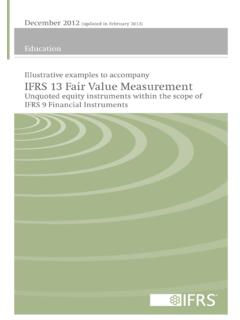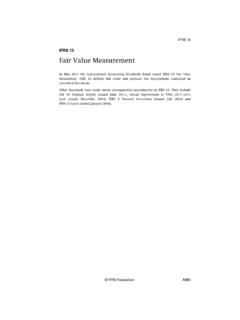Transcription of Clearly IFRS - Summary guidance and practical tips for IFRS …
1 Karen Higgins, FCPA, FCAN ational Director of Accounting ServicesClearly IFRSS ummary guidance and practical tips for ifrs 13 fair Value MeasurementIt will soon be time for many Canadian entities to file their first annual financial statements which incorporate the adoption of ifrs 13 fair Value Measurement ( ifrs 13). ifrs 13 is a standard which has broad application and the extent of the impact it has may not be fully evidenced or appreciated until the first annual financial statements which reflect the adoption of the standard. The interim reports under ifrs 13 required only a sub-set of the full ifrs 13 disclosures and many entities may not have dealt with the application of the guidance on non-recurring fair value measurements. This may prove to be publication is not intended to address comprehensively all of the detailed requirements of ifrs 13 but rather has been developed with a view to providing a refresher of the key concepts and requirements of the ifrs 13 so as to assist entities in their year-end reporting requirements.
2 Details of how and where to access our model financial statements and ifrs checklists are provided later in this hope you find this Summary guidance helpful for your reporting of fair valueAssetThe price that would be received to sell the assetFair value is an EXIT PRICEIn an orderly transactionBetween market participantsAt measurement dateLiabilityThe price that would be paid to transfer the liability Not based on how much the reporting entity has to pay to settle a liability Should be based on how much the reporting entity has to pay to a market participant such that the market participant is willing to take over the liabilityMany other IFRSs require or permit the use of fair value but prior to ifrs 13 there was no single definition or framework to be applied. ifrs 13 removes this inconsistency through a single definition to be applied to all fair value measurements and disclosures. The definition of fair value is the price that would be received to sell an asset or paid to transfer a liability in an orderly transaction between market participants at the measurement date.
3 The When and How of fair value measurementWhen to fair value: The When IFRSs are the primary IFRSs applicable to an account balance or transaction. For example, the when ifrs for a financial asset would be IAS 39 or ifrs 9 and the when ifrs for an asset classified as held for sale would be ifrs 5. Other examples are ifrs 3, ifrs 6, IAS 19 and IAS to fair value: ifrs 13 is the How ifrs to be applied when another ifrs requires or permits fair value measurement or application of ifrs 13 does, in places, refer back to the when IFRSs. For example, in the determination of the unit of account or in the assessment of whether a fair value measurement is recurring or non-recurring. ifrs 13 cannot function in isolation rather, it acts as a companion standard to the other terms of where to start in the determination of fair value, it is useful to consider three broad steps that should be taken before delving into the details that inevitably will follow.
4 These steps are important in illustrating the relationship between the primary ifrs that dictates when fair value measurement is required and ifrs 13 which is the how 1: Identify the balance or transaction that must (may) be measured or disclosed at fair value and when such measurement (disclosure) is 2: Consult ifrs 13 for guidance on how to determine fair value upon initial 3: Consult the when ifrs to determine if the subsequent measurement of the account balance is at fair value and/or if fair value disclosures are guidance and practical tips for ifrs 13 fair Value MeasurementHow to determine fair value key considerationsOnce you have established the item that is the subject of fair value measurement (and/or disclosure), the nuts and bolts of ifrs 13 come into play. The standard could appear overwhelming it is comprised of 99 paragraphs of core guidance plus a further 47 paragraphs of application guidance (Appendix B to ifrs 13).
5 As you get more familiar with the standard any fear of fair value will likely subside. In the meantime, the table which follows sets out a Summary of the key considerations in how to determine fair value under ifrs 13 requirementOur insightsUnit of account The determination of the unit of account must be established prior to determining fair value and is defined as the level at which an asset or a liability is aggregated or disaggregated in an ifrs for recognition purposes. The unit of account is determined under the ifrs applicable to the asset or liability (or group of assets and liabilities) that requires fair value measurement. The item for which fair value is determined may be a single asset or liability such as a derivative instrument or a share in a publicly traded entity or it may be a group of assets ( a portfolio of receivables), group of liabilities ( a portfolio of deposits) or group of assets and liabilities ( a cash-generating unit, a business or an asset group which is held for sale).
6 ifrs 13 does not generally provide specific guidance on the determination of the unit of the account rather it directs preparers to other IFRSs to make this determination. ifrs 13 does specifically address one area relating to the unit of account in the form of guidance for financial assets and financial liabilities with offsetting positions. Here ifrs 13 includes a portfolio exception allowing a specified level of grouping when a portfolio of financial assets and financial liabilities are managed together with offsetting markets risks or counterparty credit risk. This exception is subject to your entity meeting certain eligibility criteria. ( ifrs ).Market fair value measurement under ifrs 13 assumes that a transaction to sell an asset or to transfer a liability takes place in the principal market (or the most advantageous market in the absence of the principal market). The principal market is the market with the greatest volume and level of activity for the asset or liability.
7 The most advantageous market is the market that maximizes the amount that would be received to sell the asset or minimizes the amount that would be paid to transfer the liability, after taking into account transaction costs and transport costs. If there is a principal market, the price in that market must be used, either directly or as an input into a valuation technique. ifrs 13 does not permit the use of a price in the most advantageous market if a principal market price is available! This said, it is not necessary to perform an exhaustive search of all possible markets to identify the principal market (or, in the absence of a principal market, the most advantageous market). However, all information that is reasonably available should be considered and the basis for your conclusions should be documented. There is a presumption in the standard that the market in which the entity normally transacts to sell the asset or transfer the liability is the principal or most advantageous market unless there is evidence to the contrary.
8 Where your entity transacts in various markets (such as when assets are sold on multiple commodity and/or equity exchanges), your entity should document which particular market price is used and what process was followed to determine the appropriate market to use for determining fair participant assumptions A fair value measurement under ifrs 13 requires an entity to consider the assumptions a market participant, acting in their economic best interest, would use when pricing the asset or a participants are defined as having the following characteristics: Independent of each other ( unrelated parties). Knowledgable and using all available information. Able of entering into the transaction. Willing to enter into the transaction ( not a forced transaction). The key concept here is that the standard requires your entity to put itself in the place of a market participant and exclude any entity-specific factors that might impact the price that your entity is willing to accept in the sale of an asset or be paid in the transfer of a liability.
9 So, for example, relevant characteristics of an asset might include or relate to: The condition and location of the asset; and Restrictions, if any, on the sale or use of the asset. Here, you would need to consider the extent to which a market participant would take the above characteristics into account when pricing the asset or liability at the measurement date. The extent to which restrictions on the sale or use of the asset should be reflected in fair value are very much contingent on where the source of the restriction comes from and whether or not the restriction is separable from the asset. Depending on the particular item that is the subject of the fair value measurement, the analysis of determining exactly what a market participant would consider may, in some cases, prove to be challenging. As such, in more challenging cases, we would recommend consultation with your auditors and and valuation techniques ifrs 13 does not mandate the use of a particular valuation technique(s) but sets out a principle requiring an entity to determine a valuation technique that is appropriate in the circumstances , for which sufficient data is available and for which the use of relevant observable inputs is 13 discusses three widely used valuation techniques which are: The market approach The cost approach The income approachValuation techniques should be applied consistently from one period to the next.
10 ifrs 13 is clear that the valuation technique your entity uses must maximize the use of relevant observable inputs and minimize the use of unobservable inputs. For example, if a quoted price is available for a specific asset, this price must be used instead of an entity-specific assumption about the price. Further, there is a direct correlation between the level of disclosures required and the level of unobservable inputs the more the degree of unobservable data used in your valuation technique, the more the degree of disclosure that you must include in your financial statements. A change in a valuation technique can be made but only if the change results in a measurement that is equally or more representative of fair value. Any such change, where justified, is considered to be a change in estimate ( ifrs ).3 Summary guidance and practical tips for ifrs 13 fair Value MeasurementSpecial considerations-non-financial assets, liabilities and own equity instrumentsLayered within the requirements of ifrs 13 are specific considerations related to certain elements of the financial statements.













